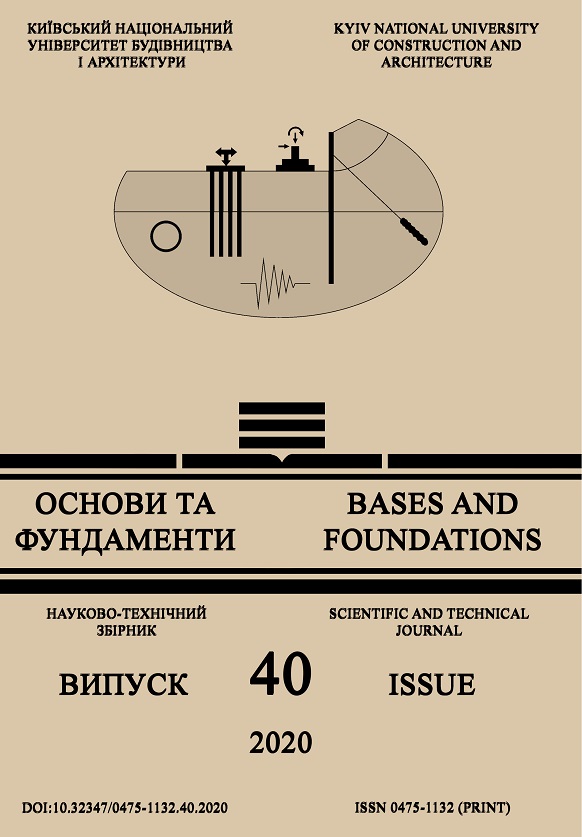Топологічна оптимізація пластини
Основний зміст сторінки статті
Анотація
У статті викладена процедура прямого (раціонального) проектування плит. Наведений біоніко-енергетичний метод є ефективним інструментарієм формування образу конструкцій, що відрізняє його від згаданих вище результатів і, насамперед, за рахунок його фізичної прозорості. Важливим також є факт використання запропонованих технологій у робочому проектуванні й зведенні конструкцій, геометрія, а при необхідності й фізичні характеристики яких, знайдені розрахунковим, а не інтуїтивним шляхом.
У його основі лежать нові енергетичні принципи й алгоритми послідовної побудови геометричного й/або фізико-механічного «образу» конструкції. На прикладі формування енергетично рівноміцних пластин показана послідовність обчислювальних операцій методу.
Рішення будується аналітично з метою показу нюансів необхідних операцій. Одночасно, на наведених прикладах, показано, що введені критерії оптимізації зумовлюють, в тому числі, мінімальний обсяг конструктивів, а також їх мінімальні прогини.
Принциповим елементом підходу є використання нового критерію граничного стану, що забезпечує оцінку напруженості елемента. При цьому, враховуються властивості матеріалу й вид напружено-деформованого стану.
Отримані аналітичні рішення використані як контрольні тести для загальної обчислювальної процедури методу. У зв'язку із чим, у статті наведені результати аналітичного й чисельного розв'язку. Ефективність обчислювальної процедури підтверджена швидкістю її збіжності і мінімальним розходженням геометричних параметрів (топології) конструкції з тест-прикладами. Технологічна послідовність обчислювальних операцій методу завершена побудовою елементів (плит) із простою зовнішньою й складною внутрішньою геометрією, що володіють цілим набором позитивних властивостей, таких як мінімальна витрата матеріалу при фіксованій жорсткості (несуча здатність), або максимальна жорсткість при фіксованій витраті матеріалу.
Блок інформації про статтю

Ця робота ліцензується відповідно до Creative Commons Attribution 4.0 International License.
Автори, які публікуються у цьому журналі, погоджуються з наступними умовами: Автори залишають за собою право на авторство своєї роботи та передають журналу право першої публікації цієї роботи на умовах ліцензії Creative Commons Attribution License, котра дозволяє іншим особам вільно розповсюджувати опубліковану роботу з обов'язковим посиланням на авторів оригінальної роботи та першу публікацію роботи у цьому журналі. Автори мають право укладати самостійні додаткові угоди щодо неексклюзивного розповсюдження роботи у тому вигляді, в якому вона була опублікована цим журналом (наприклад, розміщувати роботу в електронному сховищі установи або публікувати у складі монографії), за умови збереження посилання на першу публікацію роботи у цьому журналі. Політика журналу дозволяє і заохочує розміщення авторами в мережі Інтернет (наприклад, у сховищах установ або на особистих веб-сайтах) рукопису роботи, як до подання цього рукопису до редакції, так і під час його редакційного опрацювання, оскільки це сприяє виникненню продуктивної наукової дискусії та позитивно позначається на оперативності та динаміці цитування опублікованої роботи (див. The Effect of Open Access).Посилання
Vasilkov G.V. (2008). Evolyucijna teoriya zhittyevogo ciklu mehanichnih sistem. Teoriya sporudzhen [Evolutionary theory of the life cycle of mechanical systems. Theory of constructions]. Moskva:Vidavnictvo LKI, 320 (in Russian).
Shmukler V. (2020). Bioniko-Enerhetychna ratsionalizatsiya budivelnykh system. Trendy ta tendentsiyi rozvytku budivelnoyi haluzi [Bionic-Energy rationalization of building systems. Trends and trends in the construction industry]. Tezy dop. mizh-nar. nauk.-prakt. konf., Kharkiv: KHNUMH im. O.M. Beketova, (in Ukrainian).
Tymoshenko S.P., Voynovskyy-Kryher S. (1966). Plastynky y obolonky [Plates and shells]. per. z anhl. Moskva: Nauka, 636 (in Russian).
Banichuk N.V. (1980). Optymizatsiya form pruzhnykh tel [Optimization of forms of elastic bodies]. navch. posib. Moskva: Nauka, 256 (in Russian).
V. Babaev, I. Ievzerov, S. Evel, A. Lantoukh-Liashchenko, V. Shevetovsky, O. Shimanovskyi, V. Shmukler, M. Sukhonos (2019). Rational Design of Structural Building Systems: Monografiya. Berlin / Germany: DOM publishers, 384 (in English).
